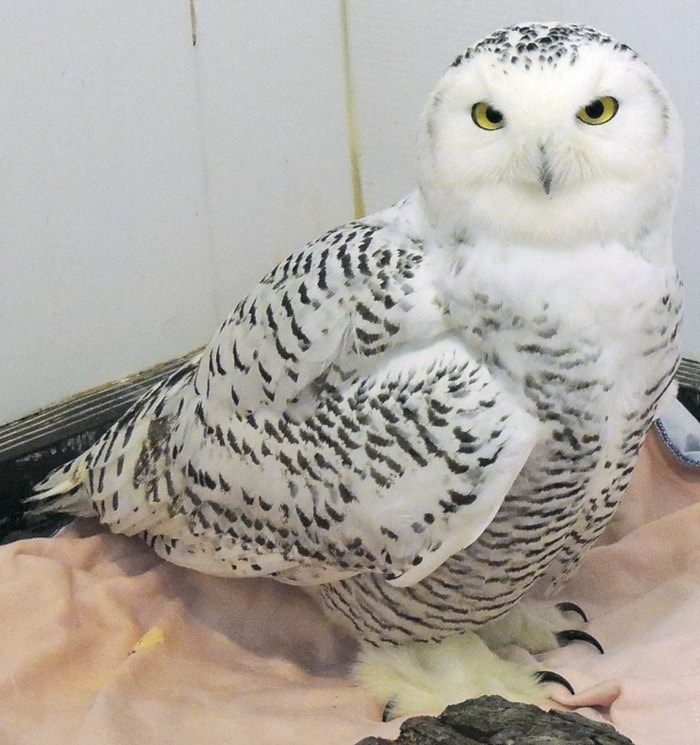Snowy owls are one of my favorite owls.
My first encounter with one of these stunning creatures was back in 2005, once a rare visitor at Mountainaire Avian Rescue Society (MARS) we are seeing more each year.
Winter is always full of surprises as weather systems can produce severe winter storms as we have seen this year. Last week birders from many places “flocked” to the Comox Valley in pursuit of a bird that is so rare that only two have ever been spotted in North America. Normally found in Asia the first North American sighting was in Mississippi 20 years ago and the present sighting in the Comox area.
This “mega rare bird alert” has taken the stage away from the sighting of another bird at risk, the snowy owl. There are many reasons why birds and other wildlife species show up in areas that they usually don’t call home. Most often in the case of birds they become disorientated or blown off course during severe storms which would certainly account for the increased number of different local birds.
However, there are other reasons why the snowy owls have strayed from their normal habitat which may be changing. In my 11 years as a volunteer at MARS, I treasure each encounter with a snowy owl. They are breathtakingly beautiful.
In the past few weeks, six snowy owls have been admitted to MARS and a further seven sightings or attempted rescues have been made. Snowy owls are one of the largest owls in North America inhabiting one of the most inhospitable environments in the world. They are found in Northern Canada and Alaska, and also in the arctic areas of Europe where they eke out their existence on the frozen tundra.
These owls stand between 52 and 71 centimeters with a wing span of 125-150 centimeters, they weigh between 1.9 and 3 kilograms, as in all raptor species the females are larger than the males.
Unmistakeable and almost ghostly in appearance, they have large white rounded heads, bright yellow eyes with subtle facial discs and a large black beak almost hidden amongst white fluffy feathers.
Their powerful legs clad in long shaggy feathers hide super sharp black talons with more feathers protruding from their between their toes. Their dense feathers are especially designed to insulate the owl against the extreme winter temperatures and they must consume vast quantities of food to provide heat and energy, often they will stand motionless to prevent heat loss.
In the summer their feathery coat can result in overheating and due to the absence of sweat glands and pores they will spread their wings and pant to cool off.
Male and female birds can be identified by size and colour, the larger female has heavy barring on her wings, head and back, the males are often completely white or speckled with a few spots and bars; juveniles closely resemble the females for the first year.
The female coloration is perfect camouflage for her when she sits on a nest hollowed out of the thawing tundra she resembles the muddy melting snow. Snowy owls are formidable, stealthy daytime hunters searching for prey between dawn and dusk.
Due to the severity of the climate they live in they are opportunistic feeders with a diet including their favorite lemmings, other rodents and small mammals, game birds, other owls and snowshoe hares. Their hunting and capture skills are also unique, they will “sit and wait” swooping down on prey even if the prey is under the snow and are also known to catch fish.
Probably one of the most versatile feats involves capturing a hare which the owl will snag in one powerful talon and then hop along with the hare until the hare has no energy left.
Why are we seeing so many snowy owls? It is thought that last year was an irruptive year for the lemming populations which rise and fall; in turn this allowed the owls to produce higher than normal quantities of eggs and the young thrived on plentiful food.
Unfortunately, the down side of an irruptive season is that the juveniles are sent packing to find their own territory and their own food supply, one might say the ultimate tough love.
Oscar the only surviving snowy owl has had a hard fought battle to regain his strength, arriving at the center extremely emaciated his progress has been very slow and labour intense. I joined other volunteers on the night feedings which were necessary every four hours.
He is now showing signs that he can take whole food in small amounts and ate a mouse on his own, offering such food too soon will kill the bird as the stress of trying to digest the food saps whatever strength they may have left. We ask people to observe any snowy owls from a distance they are easily stressed and if they appear not to move they may well be conserving what little heat and energy they have left, please stay well back and do not try to make them fly. Take advantage of the “lull between the storms” to look for birds in sheltered areas you too may see a rare visitor.
To follow “Oscars” progress go to www.wingtips.org. To report snowy owls or other injured wildlife call 1-800-304-9968, and for all other calls, 250-337-2021.
Donations are welcome we have a full house at MARS two snowy owls, eight other owls, two turkey vultures, a bald eagle, three gulls, a kingfisher, a trumpeter swan and a tundra swan, plus our three resident ambassadors.
